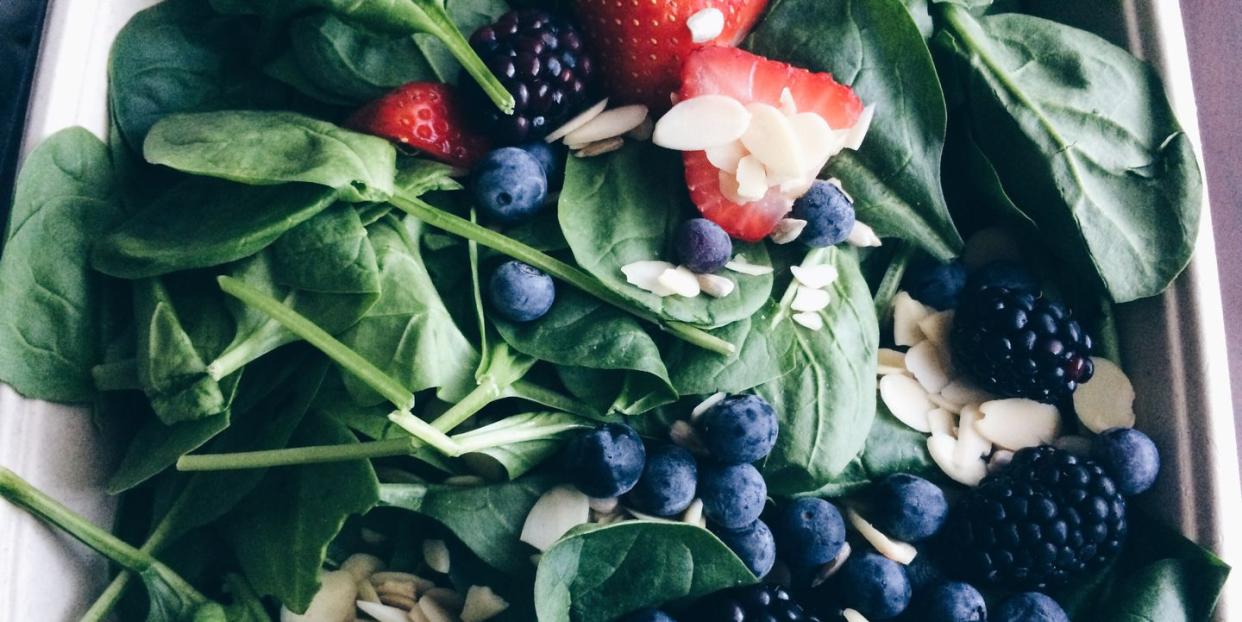This Gut-Healthy Food Trend Could Finally Get Rid of Your Bloated Belly

FODMAPs are a group of carbohydrates found in certain foods and cause stomach discomfort in some people
A low-FODMAP diet may ease irritable bowel syndrome symptoms such as gas, bloating, and diarrhea
There are dozens of high-FODMAP fruits, vegetables, and sugars, and the diet can be restrictive—but for most people, it's doable, and it's only meant to be followed for a few weeks
The word “FODMAP” probably doesn’t make your mouth water, but most of us eat at least a few of them every day. And if you’re someone who suffers from serious gastrointestinal discomfort or a condition like irritable bowel syndrome (IBS), cutting them out of your diet (at least temporarily) could spell relief.
But what are FODMAPs, exactly? FODMAPs are a group of carbohydrates found in certain foods that have one big thing in common: For some people, they’re notorious for causing stomach discomfort. These include fermentable oligosaccharides, disaccharides, monosaccharides, and polyols. Hence the name FODMAP.
Here’s what you should know about them, and whether going on a low FODMAP diet could ease your digestive woes.
Why FODMAP foods can cause stomach trouble
Foods containing FODMAPs are hard for the intestines to absorb and tend to draw lots of water into the digestive tract. They also tend to hang out in the gut for a long time, which can cause them to ferment. The end result is an uncomfortable combo of bloating, gas, and diarrhea.
A low FODMAP diet gets rid of these offending foods, usually for six to eight weeks. Then the foods are slowly reintroduced to figure out which ones are causing problems. Once you know which FODMAPs tend to trigger discomfort for you, you can avoid them permanently, explains David Bridgers, MD, a gastroenterologist at Gastroenterology Associates of North Mississippi.
Should I try a low FODMAP diet?
It might seem worth a shot if you sometimes suffer from annoying bouts of gas or bloating. But because low FODMAP diets are pretty restrictive, experts say they’re not the best option for fixing run-of-the-mill tummy troubles.
Usually, low FODMAP diets are reserved for people with severe gastrointestinal problems. Irritable bowel syndrome (IBS) is the most common one, but going low FODMAP can be an option for those with an inflammatory bowel disease like Crohn’s disease or ulcerative colitis. It might also be helpful for people with celiac disease who haven’t found relief from a gluten-free diet alone, says FODMAP and IBS expert Kate Scarlata, RDN.
Steering clear of FODMAPs might also be helpful for endurance athletes who suffer from cramping or diarrhea during races. “If you’re prone to that, it can be used as a pre-event kind of diet,” Scarlata says.
But if you’re just having occasional gas or bloating? “We wouldn’t say to go on a full FODMAP diet,” Scarlata adds. “A registered dietitian might recommend pulling out certain FODMAPs as an option, though.”
What foods are high in FODMAPs?
There are four groups of carbs that fall under the FODMAP umbrella. During the diet’s elimination phase, you’ll need to steer clear of all of them.
Oligosaccharides
High-fiber grains
Beans
Onions
Garlic
Artichokes
Lentils
Chickpeas
Broccoli
Brussels sprouts
Soy foods
Disaccharides
Milk
Yogurt
Soft cheeses
Ice cream
Monosaccharides
Mangos
Watermelon
Snap peas
Honey
Agave nectar
High fructose corn syrup
Polyols
Cherries
Nectarines
Apples
Pears
Mushrooms
Cauliflower
Sugar substitutes (xylitol, sorbitol)
Packaged foods can contain FODMAPs too, of course, so it’s also important to read labels. For instance, “natural flavors” in soups or sauces could be derived from triggers like onions or garlic. And many cereals or granola bars are sweetened with chicory root (which comes from inulin), Scarlata explains. A registered dietician can help you decipher ingredients list so you can find FODMAP-friendly versions of packaged foods you normally buy.
What about foods that are low in FODMAPs?
The amount of foods that contain FODMAPs might seem endless, but don’t worry. There are still plenty of things you can eat, say Scarlata and Patsy Catsos, MS, RDN, a medical nutrition therapist and FODMAP expert. Most people on low FODMAP diets can tolerate things like:
Blueberries
Strawberries
Cantaloupe
Oranges
Kiwifruit
Grapes
Summer squash
Green beans
Potatoes
Eggplant
Arugula
Lettuce
Spinach
Brown rice
Quinoa
Gluten-free pasta
Hard cheeses
Lactose-free milk and yogurt
Remember, FODMAPs are carbs, so you won’t find them in foods that are mostly protein or fat. That means things like meat, chicken, fish, eggs, butter, and olive oil all get the green light.
How to get started on a low-FODMAP diet
If you think that going low FODMAP could help you, talk with a gastroenterologist first. The doc can take a look at all of your symptoms and help you figure out whether a low FODMAP diet is the best option, Dr. Bridgers explains.
Your doctor can also refer you to a registered dietitian who specializes in low FODMAP diets. That’s important, since cutting out entire food groups can cause you to miss out on certain nutrients. “Calcium and fiber are two that sometimes need special attention on low FODMAP diets,” says Catsos.
An RD can also prove invaluable for bringing FODMAPs back into your diet. That’s a slow, systematic process that can take up to eight weeks, Scarlata explains. And once you’ve figured out which FODMAPs you can tolerate, they’ll help you bring those foods back gently—so you can enjoy the foods you love without feeling uncomfortable.
You Might Also Like


